This article may contain affiliate links.
Updated: 18 January, 2025
Complete guide to the Cascade Complex in Yerevan, the most representative and interesting building in the city, a visit that you cannot miss.
The Cascade Complex is the most impressive site in Yerevan, composed of an immense staircase, gardens, fountains, works of art in every corner and good views.
If I had to recommend you visit just one place in the city, it would undoubtedly be the Cascade Complex.
If you like the arts, you will love this place because there are many super interesting works.
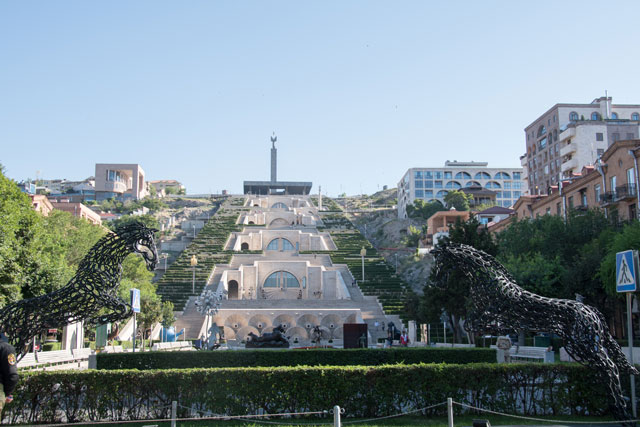
In addition, it is a museum that is very enjoyable to visit because it includes indoor spaces, but many works are outdoors and allows visits at a time that best suits you.
The Cascade Complex in Yerevan is a meeting place for local people and during the summer months it is normal for open-air concerts to be organized there.
✅ Tour to Garni, Geghard and Lake Sevan – the most surprising.
✅ Excursion to Khor Virap, Noravank and Tatev with its fabulous cable car, Alas de Tatev.
✅ Yerevan Tour – to learn about its fascinating history.
Construction of the Complex
The Cascada complex was designed by architect Alexander Tamanian, like many of the most representative buildings in the city, hence its sculpture is the first one you will encounter when you arrive at the garden area of the complex.
Tamanian designed this immense complex to connect the central part of the city with a more residential area through its 572 steps and 118 m high, an idea that was already on his mind in 1924.
However, the construction of this building began during Soviet times, specifically in 1971, and was abandoned in 1991 with the collapse of the USSR, and was partially completed.

What to see at the Cascade Complex in Yerevan?
The complex could be divided into several areas:
- An area of garden that functions as an open-air museum;
- stairs giant that in themselves are a true work of art;
- escalators inside with works of art;
- the museum galleries with permanent and temporary exhibitions;
- the stair area that is unbuilt;
- the top where the 50 years monument.
1.- The garden
The garden is the arrival point to the complex and the one that displays the largest works of art in the complex. Cafesjian Art Museum.
The first thing you find is the sculpture by Alexander Tamanian, from there to the beginning of the stairs is a beautiful garden area with a fountain.

However, what attracts the most attention are the works of art by famous sculptors, some of which are quite fun and original.
The sculptures that stand out the most are:
- 3 sculptures by the famous Colombian sculptor Fernando Botero, it is about a Roman Warrior, a Cat and the Smoking Woman;
- the nice one Blue Kiwi by American sculptor Paul Woytuk;
- the Great Teapot metal by the artist born in France and based in Portugal, Joana Vasconcelos;
- the Free on the Bell of the Welsh sculptor Barry Flanagan Known for his bronze hare sculptures exhibited throughout the globe. In the past they were also the Free Boxer and the Acrobat Hares, I didn't see them, the place where the boxer was is empty and I didn't find the acrobats;
- Sarraj Gukh's Antelope.
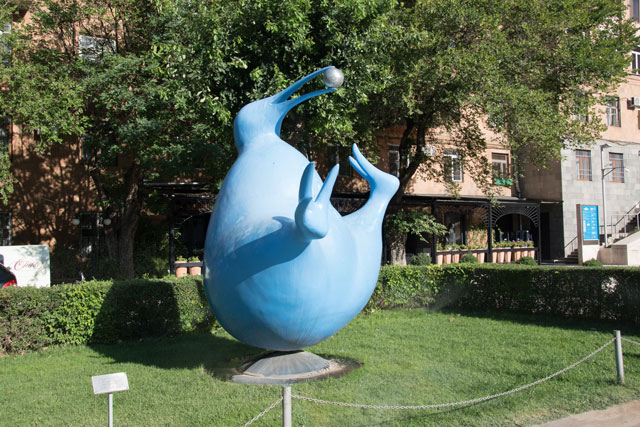
2.- Stairs (interior)
The outside area of the stairs are a beautiful architectural work of Soviet Modernist style and especially its beautifully ornamented terraces with jets that cascade down the walls, hence the name of the complex.
Each terrace is decorated differently in terms of the bas-reliefs, fountains and sculptures displayed there.
The most relevant sculptures are:

- 2 sculptures of seated people that are displayed on top of metal platforms, called «Sitting Tattoo» of the sculptor Spanish Jaume Plensa, are on the stairs next to terrace 2, one on each side. The sculptures are made of polyester resin and light up at night;
- The man who emerges from the water by the Englishman David Breuer-Weil, on terrace 2;
- the 3 divers (although they look more like synchronized swimming to me) by the sculptor David Martín, are made of stainless steel, you can find them on terrace 5.
Views from the staircase and Mount Ararat
As you go up the stairs, the views over the city become better and better until you reach terrace 5, which is the last one built.
There you will have at your feet the staircase, the gardens, the Opera house, the city and in the background the fabulous Mount Ararat.
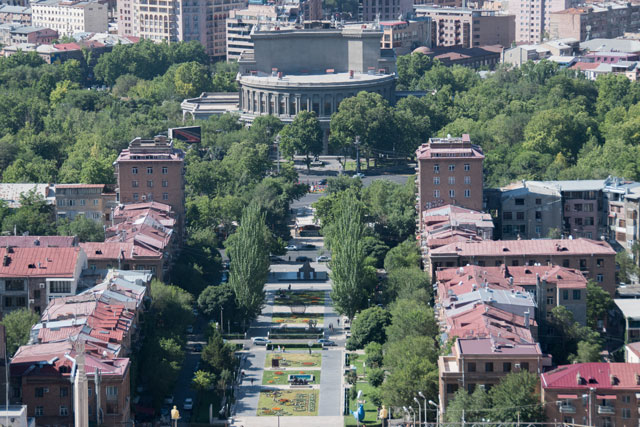
Mount Ararat is widely accepted in Islam, Judaism and Christianity as the place where Noah left his ark after the Great Flood.
This mountain is the national symbol for Armenians, although today it is in Turkish territory.
For this reason, it is represented on the Armenian Coat of Arms, it is the name of the most important brandy in the country, and the soccer team, and you will even see paintings and souvenirs with this mount.
⭐ In this other article you can read more about What to do in Yerevan: 14 best plans including a visit to the Opera House and the Brandy Museum.
3.- Escalators (interior)
You can climb the stairs from the outside and if you can't, take advantage of going inside. there are escalators.
In addition, inside there are also works displayed on the landings, on the sides and some hanging.
There are quite a few interesting works, but the one that stands out the most inside is the Great Orchid, is a glass and ceramic mosaic inlaid with semiprecious stones from the artist Maylee Christie born in Peru and raised in Argentina.
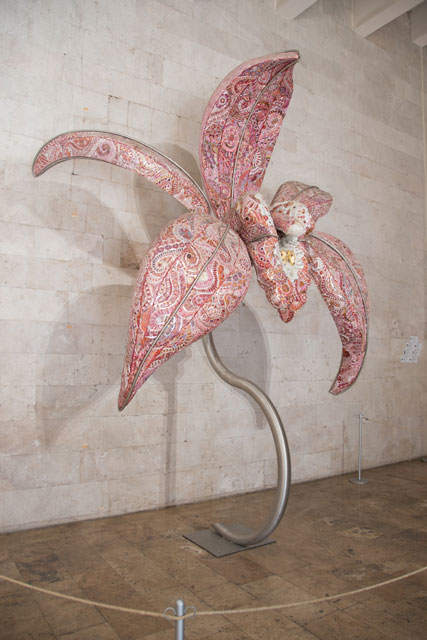
4.- Interior of the Cascada Complex
Inside the building there are also the exhibition rooms of the Cafesjian Arts Center which has permanent and temporary exhibitions, in addition to the museum store.
The most interesting exhibitions are these two:
to.- Sasuntsi Davit Gallery
The most important exhibition of the museum is the one found in the Sasuntsi Davit Gallery, where pieces of sculpture and relief on Armenian history and epic poems.
b.- Swarovski Crystal Palace
Another of the most striking exhibitions is that of Swarovski Crystal Palace, where chandeliers and chandeliers made with Svarovski crystals are displayed.
The effect of the light on the crystals is really beautiful.
These crystals are famous not for the crystals themselves but for the cutting technique that Svarovski uses, which causes the light from the lamps to be projected in a very special way.
The most important piece is the Cascade chandelier, an impressive work.
5.- Unbuilt area
From terrace 5 you can continue down the stairs outside, then a small street and more stairs that will take you to the top.
Honestly, I have to tell you that if you skip the summit part you are not missing much.
I went to the top because it was my first time in the city, but the monument is nothing special and although the height is a little more than double that from terrace 5, it's not like you see anything special, at least that's my point of view. view.
6.- Top of the complex and monument
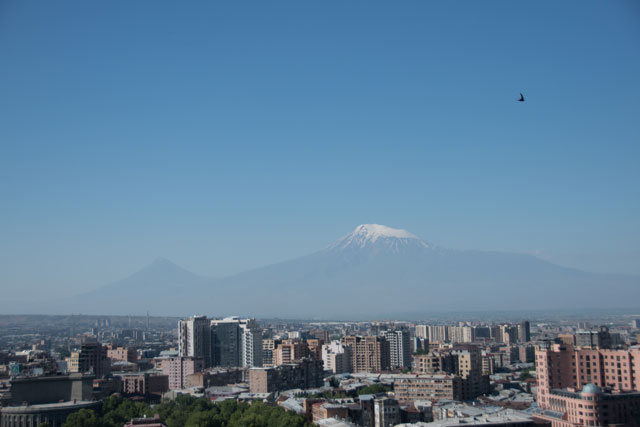
If you decide to go up, on clear days you will have good views of the city with Mount Ararat.
At the top there is an obelisk 54 m high, it is a commemorative symbol of 50 years of Soviet rule in Armenia, a way to remind them of what they had obtained thanks to it.
Practical Info
- Location: in the center just behind the Opera and Ballet Theater.
- Schedules:
- Mechanic stairs: They are open every day from 8 a.m. to 8 p.m.
- interior exhibition halls: Friday to Sunday from 10 a.m. to 8 p.m. and closed on national holidays.
- museum store: Tuesday to Thursday from 10 a.m. to 6 p.m. and Friday to Sunday from 10 a.m. to 8 p.m.
- Entrance Fee: everything is free, even the interior rooms of the museum.
- Official Web
More about Armenia
- What to do in Yerevan: 14 best plans
- Tips for traveling to Armenia
- What to see in Armenia: 25 essentials from Yerevan
- Route through Armenia: 1 week itinerary
- How to Get from Tbilisi to Yerevan: Fast, Cheap, and Comfortable
- 31 Curiosities of Armenia

Hello, I’m Andrea, the creator and writer of Viajeros Activos (Active Travelers). I’m a nomad, so I consider myself a full-time traveler. I’m passionate about good food and always looking for new adventures.